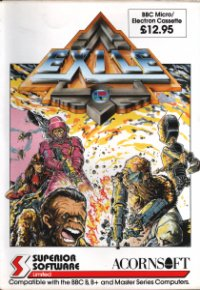
Exile is a single-player action-adventure video game originally published for the BBC Micro and Acorn Electron in 1988 by Superior Software and later ported to the Commodore 64, Amiga, CD32 and Atari ST, all published by Audiogenic. The game was designed and programmed by Peter Irvin and Jeremy Smith. It is often cited as one of the earliest examples of a Metroidvania game and featured "realistic gravity, inertia and object mass years before players understood the concept of a physics engine... an astounding level of AI, stealth-based gameplay, a logical ecosystem governing the world's creatures and a teleportation mechanic that feels startlingly like a predecessor to Portal".
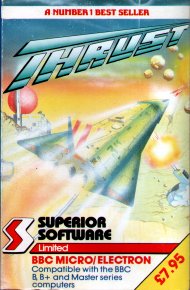
Thrust is a 1986 video game programmed by Jeremy C. Smith for the BBC Micro and published by Superior Software. The player's aim is to manoeuvre a spaceship by rotating and thrusting, as it flies over a two-dimensional landscape and through caverns. The gameplay of Thrust was heavily inspired by Atari's Gravitar.

Ork is a video game made for the Amiga and Atari ST personal computers. It was developed by WJS Design and published by Psygnosis in 1991.
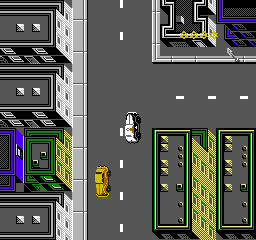
Dick Tracy appeared in the following video game tie-ins for the motion picture:

Captive is a science fiction role-playing video game released by Mindscape in 1990. In the style of Dungeon Master, it uses pseudo-3D realtime graphics from a first-person perspective. It was released for Amiga, Atari ST, and, in 1992, MS-DOS.

Awesome is a science fiction action video game released by Psygnosis for the Amiga in 1990. It features a variety of gameplay styles, from overhead shooting to Asteroids-esque sequences, and a pre-rendered ray-traced intro. The objective is to traverse the galaxy despite not having funds or fuel to do it.
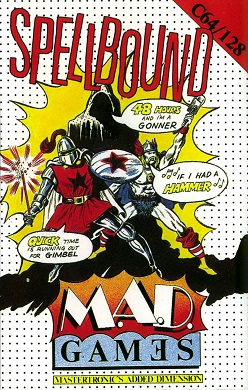
Spellbound is a video game that was designed and programmed by David Jones with music by Rob Hubbard and released in 1985 for the ZX Spectrum and Amstrad CPC home computers. Versions for the Commodore 64 and the Atari 8-bit computers and an enhanced 128K Spectrum version with music and additional graphics were all released in 1986. Unlike the other Magic Knight games, Spellbound was never released for the MSX system back in 1985, but an authorized version was finally released by Tracy Lewis in 2023. It is the second game in the Magic Knight series and was published by Mastertronic as part of their Mastertronic Added Dimension label.
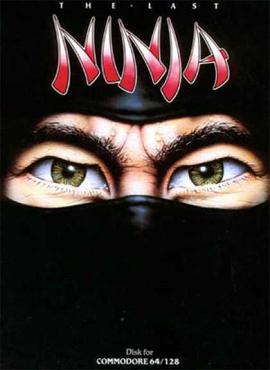
The Last Ninja is an action-adventure game originally developed and published by System 3 in 1987 for the Commodore 64. It was converted to the Apple IIGS, MS-DOS, BBC Micro and Acorn Electron in 1988, the Apple II series in 1989, the Amiga and Atari ST in 1990, and the Acorn Archimedes in 1991.

Astro Chase is a multidirectional shooter written by Fernando Herrera for Atari 8-bit computers. It was published by First Star Software in 1982 as the company's first game. Parker Brothers licensed it, releasing cartridge versions for the Atari 8-bit family and Atari 5200 console in 1983 and a Commodore 64 version in 1984. Exidy licensed it for arcade use with its Max-A-Flex cabinet.

Imogen is a computer game released in 1986 for the BBC Micro. It was written by Michael St Aubyn and published by Micro Power. It was reissued as the lead game of Superior Software / Acornsoft's Play It Again Sam 5 compilation in 1988 when it was also converted for the Acorn Electron. It is a platform game featuring puzzles.

Cosmic Ark is an Atari 2600 game designed by Rob Fulop and published by Imagic in 1982. The objective is to gather specimens from different planets in a spaceship which contains the survivors from the city of Atlantis. There are two versions of the cartridge. One allows the player to toggle the starfield display with the Black & White / Color TV switch. In the other the starfield cannot be disabled.
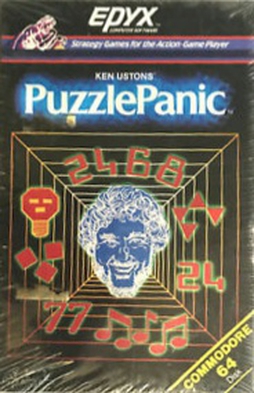
Puzzle Panic, also known as Ken Uston's Puzzle Panic, is a puzzle video game created by blackjack strategist Ken Uston, Bob Polin, and Ron Karr. It was published by Epyx in 1984 for the Atari 8-bit computers and Commodore 64.

Protostar: War on the Frontier is a 1993 science fiction video game produced by Tsunami Media that blends elements of role-playing, space exploration, space combat, and strategy. The player commands a spaceship from a first-person perspective in real-time capable of traveling to the various planets in the game world and launching an explorer vessel to traverse their surfaces. Several sentient alien races inhabit the region with whom the player interacts through friendly conversation, intense spaceship combat, or barter at their planetary trading posts. One of these races, the Skeetch, is aggressively threatening to conquer the Earth; the player has been recruited to convince the other sentient races in the region to join humanity in an alliance against the Skeetch. A secondary goal of the game is to earn money by performing actions such as selling alien lifeforms and minerals collected on planetary surfaces to obtain the funds needed to upgrade the player's spaceship and improve the odds of survival in confrontations with the Skeetch and other hostile entities. Computer Gaming World criticized the game for failing to break new ground and for its "muddled" blend of science fiction themes, but did recommend it to players new to this genre.

Several video games and genres have been created as a result of the release of the film E.T. the Extra-Terrestrial based on the story and themes of the original game.

Gnome Ranger is a graphic adventure game designed by Peter Austin and released by Level 9 in 1987. A still image is shown for each location, and the player enters text commands to move or interact. Ports to the Apple II and Atari 8-bit computers are text-only. A sequel was published in 1988: Ingrid's Back.

Star Trek: The Rebel Universe is an action-adventure computer game published by Firebird Software in Europe and Simon & Schuster Interactive in America. It was originally released for the Atari ST in 1987, and was followed the next year with versions for the Commodore 64 and DOS.
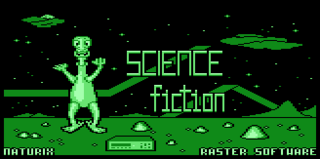
Naturix is a 1994 action-adventure game developed by Radek Štěrba for Atari 8-bit computers.

Planet of Lust is a 1989 erotic text adventure game developed and self-published by Free Spirit Software, and released for Commodore 64, DOS, Atari ST, and Amiga. The Amiga version of Planet of Lust was released in Europe in April 1989. Planet of Lust is the second game in the Brad Stallion series; it is preceded by Sex Vixens from Space (1988), and succeeded by Bride of the Robot (1989) and Sex Olympics (1991).

Threshold is a space-themed fixed shooter written by Warren Schwader and Ken Williams for the Apple II and published by On-Line Systems in 1981. Inspired by Sega's Astro Blaster arcade video game, Threshold introduces many enemy ship types and wave formations as the game progresses. Reviewers found the variety distinguished the game from the many similar shoot 'em ups.

Action Quest is a video game written by Jack Verson for Atari 8-bit computers. It was published in 1982 by his company, JV Software. Action Quest combines real-time action with puzzle solving as the player explores 30 rooms in an attempt to collect 20 treasures. Reviewers found the combination to be different from how puzzles in games—such as graphic adventures—worked at the time.





















